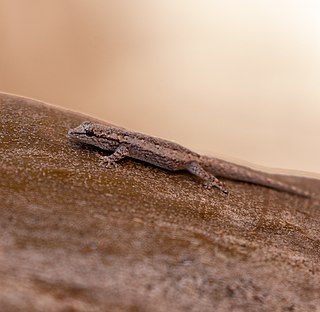
Gekko is a genus of Southeast Asian geckos, commonly known as true geckos or calling geckos, in the family Gekkonidae. Although species such as Gekko gecko are very widespread and common, some species in the same genus have a very small range and are considered rare or endangered.

Phyllodactylus is a genus of geckos distributed in South America and Central America, and as far north as the southern United States. They are commonly known as "leaf-toed geckos" in their native range, and otherwise as American leaf-toed geckos to distinguish them from unrelated genera with similar feet.
Lutz's gecko, also known commonly as Bogert's gecko and Lutz' marked gecko, is a species of lizard in the family Phyllodactylidae. The species is endemic to Brazil.

Gymnodactylus is a genus of Brazilian geckos, commonly known as naked-toed geckos, in the family Phyllodactylidae.

The Phyllodactylidae are a family of geckos (Gekkota) consisting of over 150 species in 10 genera, distributed throughout the New World, North Africa, Europe and the Middle East. The family was first delineated based on a molecular phylogenetic analysis in 2008, and all members possess a unique single codon deletion in the phosducin (PDC) gene. The phyllodactylid genus Bogertia has been recently synonymized with Phyllopezus. The name of the family comes from the leaf shaped fingers.

Kluge's dwarf gecko is a species of gecko, a lizard in the family Gekkonidae. The species is native to northeastern Brazil.
Gymnodactylus amarali is a species of gecko in the family Phyllodactylidae. The species is endemic to Brazil.

Gymnodactylus vanzolinii is a species of gecko in the family Phyllodactylidae. The species is endemic to Brazil.
Phyllodactylus delsolari is a species of gecko, a lizard in the family Phyllodactylidae. The species is endemic to Peru.
The Rio Huancabamba leaf-toed gecko is a species of lizard in the family Phyllodactylidae. The species is endemic to Peru.

Phyllodactylus reissii, also known commonly as Peters' leaf-toed gecko or the coastal leaf-toed gecko, is a species of lizard in the family Phyllodactylidae. The species is endemic to northwestern South America.
Phyllodactylus thompsoni is a species of gecko, a lizard in the family Phyllodactylidae. The species is endemic to Peru.
Phyllopezus heuteri is a species of gecko, a lizard in the family Phyllodactylidae. The species is endemic to Paraguay.
Phyllopezus maranjonensis is a species of gecko, a lizard in the family Phyllodactylidae. The species is endemic to Peru.
The Paraíba gecko, also commonly called the Peraiba gecko, is a species of gecko, a lizard in the family Phyllodactylidae. The species is endemic to Brazil.

The Brazilian gecko is a species of gecko, a lizard in the family Phyllodactylidae. The species is endemic to South America. The Brazilian gecko feeds mostly on arthropods, specifically Diptera.
Przewalsky's gecko is a species of gecko, a lizard in the family Phyllodactylidae. The species is endemic to South America.

Haseman's gecko is a species of lizard in the family Sphaerodactylidae. The species is indigenous to northern South America.
Gonatodes nascimentoi is a species of lizard in the family Sphaerodactylidae. The species is endemic to Brazil.
Phyllopezus selmae is a species of gecko, a lizard in the family Phyllodactylidae. The species is endemic to northeastern Brazil.







